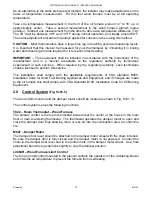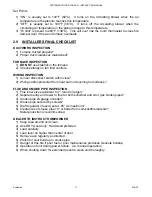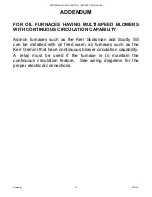
SCOTSMAN WOOD FURNACE – INSTRUCTION MANUAL
Scotsman
Jun
-10
10
2.4.1 COMBUSTION AIR SUPPLY
Air inlets of at least 200 square inches free area (1.5 in
2
/1000Btu) must be provided to the
room occupied by the wood fired or oil fired furnace. These fresh air inlets must provide or
allow free access of fresh outside air to the furnace. At no time or under any circumstances
can a wood or oil-burning appliance be starved of combustion air.
The appliance must at all times be able to maintain the approved stack draft. The barometric
draft regulator must be installed on the furnace smoke pipe in the same room or at least in
such a way that there is unrestricted free passage of air between the combustion air inlet to the
furnace or burner and the barometric draft regulator.
It is important to provide adequate combustion air to the furnace. It may be necessary to add a
ventilator to an exterior wall of a closed furnace room or an airtight basement.
Operating a wood or oil fired appliance with inadequate combustion air could be hazardous.
2.4.2 FLUE PIPE & CHIMNEY
The internal breech baffle should be inserted through the breech towards the front of the
furnace until it hits the internal baffle stop. The open slot running the length of the baffle
should be located on the top. This baffle is removed during the cleaning procedure. The
purpose of the baffle is to prevent short-circuiting of the flue gases out through the rear breech.
The flue gases are forced to fully heat the secondary heat exchanger, which will maintain
higher furnace efficiency.
The furnace must be located to meet a minimum venting distance needed between the furnace
and the flue. It should also be ducted so that there are a minimum number of elbows used.
The flue pipe must be installed with a gradual rise of 1/2” or more per foot from the furnace to
the flue.
NEVER ALLOW THE SMOKE PIPE TO RUN DOWNHILL TO THE FLUE!
The smoke pipe and chimney should be at least 7 inches in diameter. The flue pipe or a
chimney may be of different cross-sectional area than that of the appliance smoke pipe,
provided that sufficient draft is available at the appliance. Space must be provided around the
smoke pipe and the back of the furnace to allow easy access for the purpose of cleaning.
Smoke pipes must not be lighter than 24 gauge black steel. All pipes must be securely
fastened with at least 3 sheet metal screws at every joint, and properly supported.
Always meet or exceed flue pipe clearance specifications - 18” clearance from flue pipe to
combustibles in all directions.
Connect the furnace only to an approved chimney suitable for solid fuel appliances and
capable of venting the products of combustion. The chimney must be installed with proper
clearances above roof and from adjacent structures and trees. If a masonry chimney is used it
must be in good condition and be equipped with a tile liner. Flue thimble or flue pipe must not
extend into the chimney flue, as it will reduce the draft.
Connect only to a flue or chimney capable of maintaining a negative draft of .05” wc at all times
and conditions.


























